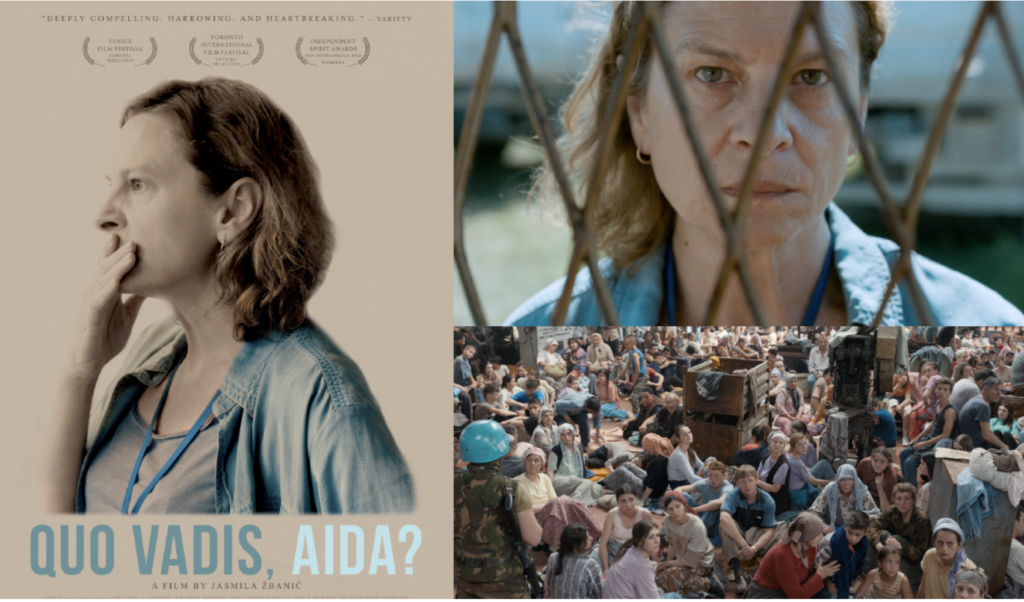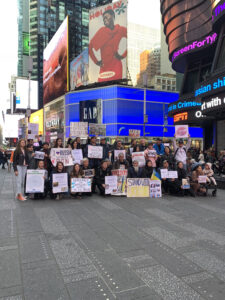Historical Film Review: Quo Vadis, Aida? and the 1995 Srebrenica Massacre
Foreign war drama, Quo Vida, Aida? offers heartbreaking and powerful insight into the July 1995 Srebrenica Massacre, an eleven day event of the Bosnian War.

Image Credit: Museum of Tolerance
Foreign war drama, Quo Vida, Aida? offers heartbreaking and powerful insight into the July 1995 Srebrenica Massacre, an eleven-day event of the Bosnian War. It calls attention to an event that receives relatively little publicity and exemplifies the ability and power of film to explore history and war.
This film is directed and portrayed as a war drama, sharing the story from the perspective of a former teacher-turned-translator for the United Nations. Aida’s role in the film connects the storyline, through her duties to the United Nations, to her previous life with her family and her community. This connection is exemplified as you see Aida struggle through her duties to the United Nations and through her duty to her people and family.
Throughout the film, Aida has flashbacks to her former life before the war. The imagery in this movement draws parallels between pre-war normalcy and rising tensions established during the outbreak of conflict, further exemplifying common social trends that reveal themselves during times of war: those who were once your neighbor or friend turn against you with manipulative narratives or shifted perspectives. This is shown, for example, when Aida makes pleasantries with a Serbian soldier; in her pre-war life, this soldier was a former student, but now holds the status of the enemy under the pretense of sudden war.
The relationship between one’s duty to country and one’s duty to protect those closest to you is another powerful portrayal in the film. In Aida’s case, this relationship is present with is her two sons and her husband. Quo Vida, Aida? does not hold back in revealing these complicated dynamics. Aida’s frustration and fear are evident when her limited protections as a translator for the United Nations are not extended to her family. She fears for them as they hold refugee status, and remains concerned about their survival at the expense of her position.
Understanding the history behind the film gives greater context to the building tensions and themes presented through Aida’s experience. The film is based on the historical events of the Bosnian War in 1995. In the Srebrenica Massacre, more than 8,000 Muslim boys and men were killed by Bosnian Serb forces. At the time, it was the largest atrocity to occur on European soil since the end of the World War II.
Bosnian Serb forces also expelled more than 20,000 civilians from their homes in an act of ethnic cleansing
During this dispute, Bosnian Serb forces also expelled more than 20,000 civilians from their homes in an act of ethnic cleansing. After much deliberation, the International Criminal Tribunal came to a conclusion. With consideration to this act of ethnic cleansing, the mass murder of 8,000 Bosniaks, and the added traumatization faced by the Bosniaks, the tribunal designated these violent acts as acts of genocide.
The Srebrenica Massacre took place within an area that the United Nations had designated as “safe” during the conflict. The United Nations took some of the blame for having failed to protect the Bosniak people in Srebrenica, but Serbia was never legally implicated in the genocide of the Bosniak men. The campaign of ethnic cleansing was led by Radovan Karadžić, president of the Bosnian Serb Republic, a self-declared republic directed by Karadžić and his military forces.
What led to the ultimate conflict portrayed in this film was given under the order of Karadžić, which was to “create an unbearable situation of total insecurity with no hope of further survival or life for the inhabitants of Srebrenica.” This order led to embargoes on food and other resources. The Bosnian Serb forces were ordered to burn the homes of the Bosniak people to insight terror and “cleanse” the regions. These acts of terror are what eventually concluded in the Bosniak people fleeing the United Nations designated “safe zone,” and to their tragic death.
The uncertainty of her future and the future of her family remained one of her largest fears
It was clear that in her circumstances, Aida felt trapped. Even within the “safety” region under the control of the United Nations, she felt unprotected. The uncertainty of her future and the future of her family remained one of her largest fears; the fear of not knowing how she could ensure their safety and barely providing them with protection despite her status. The survival of her family was dismal, as was that of the other refugees and their families.
This film shows that there is cruelty throughout history; however, it also provides a sense of hopefulness in the resilience of the people. It shows that taking a stand can and will make a difference. Even in the aftermath of the massacre, and decades after the tragic deaths of the Bosniak boys and men, mass graves are still being discovered and bodies remain unidentified, increasing the number of deaths to the calamity of the events at Srebrenica.
The end of the film shows raw aggression and mourning. It shows shock and fear in the aftermath of so much violence and death. It shows people attempting to rebuild but also grieving what was lost. It shows uncertainty, hope, and pain. The reason a film such as this one is so significant in its portrayal of history is to show an authentic representation of historical events, providing a narrative of adaptation to new realities and norms after conflict. The film reveals that there is no tidy way to end history, for it is ever-changing and evolving. Aida acclimated to her new reality, despite how tragic her story end was revealed. She showed that both emotion and adaptations in societal views play a major role in history and in the path forward toward new realities for the future.
Anastasia Boulos (she/her) is a first-year MA student in NYU’s International Relations department with a concentration in international law. She received her BA degree from Boston University in 2021, where she majored in International Relations, with a concentration in regional politics and cultural anthropology in the Middle East and North Africa. Anastasia additionally minored in public relations as an undergraduate student. Anastasia’s work experiences come from internships throughout undergrad, working with non-profit organizations, a law firm, and the Massachusetts Department of Education. She continues to participate in academic leadership roles. Her continued interest in her field of study focuses on international law, forced migration, and immigration crisis specifically in the Middle East and North Africa region. When not working, Anastasia enjoys listening to good music, visiting art museums, and spending quality time with friends and family.





